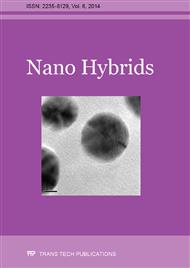[1]
J. van den Boogaard, G.S. Kibiki, E.R. Kisanga, M.J. Boerre, R.E. Aarnoutse, New drugs against tuberculosis: problems, progress, and evaluation of agents in clinical development, Antimicrob. Agents Chemother. 53 (2010) 849-862.
DOI: 10.1128/aac.00749-08
Google Scholar
[2]
T. Gumbo, C.S.W. Siyambalapitiyage Dona, C. Meek, R. Leff, Pharmacokinetics-pharmacodynamics of pyrazinamide in a novel in vitro model of tuberculosis for sterilizing effect: a paradigm for faster assessment of new antituberculosis drugs, Antimicrob. Agents Chemother. 53 (2009) 3197-3204.
DOI: 10.1128/aac.01681-08
Google Scholar
[3]
Y.L. Janin, Antituberculosis drugs: ten years of research, Bioorg. Med. Chem. 15 (2007) 2479-2513.
Google Scholar
[4]
F. Faridbod, M.R. Ganjali, E. Nasli-Esfahani, B. Larijani, S. Riahi, P. Norouz, Potentiometric sensor for quantitative analysis of pioglitazone hydrochloride in tablets based on theoretical studies, Int. J. Electrochem. Sci. 5 (2010) 880-894.
Google Scholar
[5]
K. Grennan, A.J. Killard, C.J. Hanson. Optimisation and characterisation of biosensors based on polyaniline, Talanta 68 (2006) 1591-1600.
DOI: 10.1016/j.talanta.2005.08.036
Google Scholar
[6]
N. Gospodinova, L. Terlemezyan. Conductive Polymers Prepared by Oxidative Polymerization: Polyaniline, Prog. Polym. Sci. 23 (1999) 1443-1484.
DOI: 10.1016/s0079-6700(98)00008-2
Google Scholar
[7]
M. Matsuguchi, A. Okamoto, Y. Sakai. Effect of humidity on NH3 gas sensitivity of polyaniline blend films, Sens. Actuators, B 94 (2003) 46-52.
DOI: 10.1016/s0925-4005(03)00325-3
Google Scholar
[8]
L. Zhang, P. Liu, Synthesis of hollow polyaniline nanoparticles with reactive template, Mater. Lett. 64 (2010) 1755-1757.
DOI: 10.1016/j.matlet.2010.04.042
Google Scholar
[9]
M.D. Bedre, R. Deshpande, B. Salimath, V. Abbaraju, Preparation and characterization of polyaniline-CO3O4 nanocomposites via interfacial polymerization, Am. J. M. Sci. 2 (2012) 39-43.
DOI: 10.5923/j.materials.20120203.01
Google Scholar
[10]
Drelinkiewicz, M. Hasik, M. Choczyn´ski, Preparation and properties of polyaniline containing palladium, Mater. Res. Bull. 33 (1998) 739-762.
DOI: 10.1016/s0025-5408(98)00042-7
Google Scholar
[11]
T.H. Le, N.T. Trinh, L.H. Nguyen, H.B. Nguyen, V.A. Nguyen, D.L. Tran, T.D. Nguyen, Electrosynthesis of polyaniline–mutilwalled carbon nanotube nanocomposite films in the presence of sodium dodecyl sulfate for glucose biosensing, Adv. Nat. Sci. Nanosci. Nanotechnol. 4 (2013) 025014-025019.
DOI: 10.1088/2043-6262/4/2/025014
Google Scholar
[12]
E.I. Iwuoha, D. Saenz de Villaverde, N.P. Garcia, M.R. Smyth, J.M. Pingarron, Reactivities of organic phase biosensors. 2. The amperometric behaviour of horseradish peroxidase immobilised on a platinum electrode modified with an electrosynthetic polyaniline film, Biosens. Bioelectron. 12 (1997) 747-761.
DOI: 10.1016/s0956-5663(97)00042-0
Google Scholar
[13]
W. Li, Y. Zheng, X. Fu, J. Peng, L. Ren, P. Wang, W. Song, Electrochemical characterization of multi-walled carbon nanotubes/polyvinyl alcohol coated electrodes for biological applications, Int. J. Electrochem. Sci. 8 (2013) 5738-5754.
Google Scholar
[14]
W. Wang, J. Chen. Tuberculosis of the head and neck: a review of 20 cases, Oral Surg. Oral Med. Oral Pathol. Oral Radiol. Endod. 107 (2009) 381-382.
DOI: 10.1016/j.tripleo.2008.11.002
Google Scholar
[15]
Liu, K. Sun, J. Yang, D. Zhao, Toxicological effects of multi-wall carbon nanotubes in rats, J. Nanopart. Res. 10 (2008) 1303-1307.
DOI: 10.1007/s11051-008-9369-0
Google Scholar
[16]
L. Ji, L. Zhou, X. Bai, Y. Shao, G. Zhao, Y. Qu, C. Wang, Y. Li, Facile synthesis of multiwall carbon nanotubes/iron oxides for removal oftetrabromobisphenol A and Pb(II), J. Mater. Chem. 22 (2012) 15853-15862.
DOI: 10.1039/c2jm32896h
Google Scholar
[17]
S.B. Kondawar, M.D. Deshpande, S.P. Agrawal, Transport properties of conductive polyaniline nanocomposites based on carbon nanotubes, International Journal of Composite Materials 2 (2012) 32-36.
DOI: 10.5923/j.cmaterials.20120203.03
Google Scholar
[18]
K.M. Molapo, P.M. Ndangili, R.F. Ajayi, G. Mbambisa, S.M. Mailu, N. Njomo, M. Masikini, Electronics of conjugated polymers (I): polyaniline, Int. J. Electrochem. Sci. 7 (2012) 11859-11875.
Google Scholar
[19]
E. Iwuoha, S.E. Mavundla, V.S. Somerset, L.F. Petrik, M.J. Klink, M. Sekota, P. Baker, Electrochemical and spectroscopic properties of fly ash- polyaniline matrix nanorod composite, Microchim. Acta 155 (2006) 453-458.
DOI: 10.1007/s00604-006-0584-z
Google Scholar
[20]
M. Muchindu, E. Iwuoha, E. Pool, N. West, N. Jahed, P. Baker, T. Waryo, A. Williams, Electrochemical ochratoxin A immunosensor system developed on sulphonated polyaniline, Electroanalysis 23 (2011) 122-128.
DOI: 10.1002/elan.201000452
Google Scholar
[21]
T. Mulaudzi, N. Ludidi, O. Ruzvidzo, M. Morse, N. Hendricks, E. Iwuoha, C. Gehring, Identification of a novel Arabidopsis thaliana nitric oxide-binding molecule with guanylate cyclase activity in vitro. FEBS Lett. 585 (2011) 2693-2697.
DOI: 10.1016/j.febslet.2011.07.023
Google Scholar
[22]
E.I. Iwuoha, M.R. Smyth, Reactivities of organic phase biosensors: 6. square-wave and differential pulse studies of genetically engineered cytochrome P450cam (CYP101) bioelectrodes in selected solvents. Biosens. Bioelectron. 18 (2003) 237-244.
DOI: 10.1016/s0956-5663(02)00180-x
Google Scholar
[23]
E. Iwuoha, F. Ngece, M. Klink, P. Baker, Amperometric responses of CYP2D6 drug metabolism nanobiosensor for sertraline: a selective serotonin reuptake inhibitor. IET Nanobiotechnol. 1 (2007) 62-67.
DOI: 10.1049/iet-nbt:20070005
Google Scholar
[24]
M.Y. Khuhawar, F.M. Rind, Liquid chromatographic determination of isoniazid, pyrazinamide and rifampicin from pharmaceutical preparations and blood, J. Chromatogr. B 766 (2002) 357-63.
DOI: 10.1016/s0378-4347(01)00510-2
Google Scholar
[25]
H. McIlleron, P. Wash, A. Burger, J. Norman, P.I. Folb, P. Smith, Determinants of rifampin, isoniazid, pyrazinamide and ethambutol pharmacokinetics in a cohort of tuberculosis patients, Antimicrob. Agents Chemother. 50 (2006) 1170-1177.
DOI: 10.1128/aac.50.4.1170-1177.2006
Google Scholar
[26]
E. Nxusani, P.M. Ndangili, R.A. Olowu, A.N. Jijana, T. Waryo, N. Jahed, R.F. Ajayi, P. Baker, E. Iwuoha, 3-Mercaptopropionic acid capped Ga2Se3 nanocrystal-CYP3A4 biosensor for the determination of 17-alpha-ethinyl estradiol in water, Nano Hybrids 1 (2012) 1-22.
DOI: 10.4028/www.scientific.net/nh.1.1
Google Scholar
[27]
P.N. Ndangili, A.M. Jijana, P.G.L. Baker, E.I. Iwuoha, 3-Mercaptopropionic acid capped ZnSe quantum dot-cytochrome P450 3A4 enzyme biotransducer for 17 beta-estradiol. J. Electroanal. Chem. 653(1-2) (2011) 67-74.
DOI: 10.1016/j.jelechem.2010.12.029
Google Scholar


